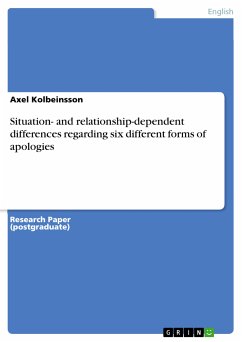Seminar paper from the year 2005 in the subject English Language and Literature Studies - Linguistics, grade: 2,0, University of Rostock (Anglistik (Amerikanistik)), course: Proseminar, language: English, abstract: Politeness is the flower of humanity", (Joseph Joubert , 1754 - 1824, French moralist). "Politeness is to human nature what warmth is to wax", (Arthur Schopenhauer, 1788- 1860, German philosopher). Politeness and tact play an important role in dealing with other people. The term calls a behaviour that shall demonstrate respect for the vis - à - vis. In order to avoid embarrassing situations or abashing someone polite behaviour has to be used. In the following paper, I will deal with the topic "Politeness in English and Japanese." As a basic concept I will use two essays: "Politeness and conversational universalsobservation from Japanese" by Yoshiko Matsumoto (1989) and "Keigo - Höflichkeit und soziale Bedeutung im Japanischen" by Florian Coulmas (1987). On the basis of these two papers I want to show what politeness is like in Japanese and English and whether the principles of conversation generated by Grice (1975) and Brown and Levinson's theory of politeness (1978, 1987) are universal as they are claimed to be. In order to analyse this assertion I will take a closer look on the Japanese language. At first I will give basic information to understand what the respective theory is about. I will first give an overview of Grice's theory and will then focus on Brown and Levinson's theory of politeness and explain their notion. The next point will comprise the transformation of the theories' properties on the Japanese language to confute or verify their alleged universality. I will use Matsumoto's and Coulmas' essays to indicate the construction of the Japanese language and will demonstrate this with many examples. Subsequently I will illustrate whether Brown and Levinson's theory is also appropriate for the Japanese language system. Section five will give a summary of the topic and present the result of the analysis.
Dieser Download kann aus rechtlichen Gründen nur mit Rechnungsadresse in A, B, BG, CY, CZ, D, DK, EW, E, FIN, F, GR, HR, H, IRL, I, LT, L, LR, M, NL, PL, P, R, S, SLO, SK ausgeliefert werden.









